Contextual Scouting: Next Breakout Stars in Asia
The article is exploring a scouting scenario from a specific club perspective - putting contextual scouting into practice with the goal of finding the next breakout stars in emerging markets.

Every season, a handful of players break through from leagues outside the ‘Big Five’. They arrive under the radar, adapt quickly, and become key contributors - sometimes even turning into major transfers within a year or two. So how do some clubs spot these players early, while others miss out?
Talent alone isn’t enough. To succeed, a player needs to match a team’s style, system, and role expectations - in possession and out of possession. That’s where Contextual Scouting comes in. With this approach, the goal is simple: help clubs find players who match specific tactical and stylistic needs both in and out of possession. Not just “good” players, but the right ones - increasing the certainty around these key investments.
The second part of effective scouting, and what we want to focus on here, is identifying emerging talent in and ‘untapped’ leagues and markets that can generate high resale value. In this piece, we combine the two frameworks introduced in our earlier articles - the Playmaker Index and the Pressing Index - to create a Total Index Score. This score captures a player’s overall impact on the game by evaluating their attacking and defensive contributions in tandem, offering a more complete scouting lens. We’ll go through some realistic scenarios for clubs in different situations to show how these scores can add precision and more certainty in recruiting for key positions, focusing on emerging markets; places where quality often goes unnoticed, and where value can be found before prices skyrocket. Our next stop is Asia, using data from the current 2025 season.

Exploring the Japanese Market
The next market we aim to explore is Asia, with a particular focus on the Japanese J1-League. In recent years, Japan has emerged as a highly attractive talent pool, thanks to a well-organized youth development system and a clear national footballing philosophy. These long-term structural investments are now bearing fruit, producing technically gifted and tactically disciplined players.
Japanese exports have consistently adapted well to a variety of competitive environments, from the English Championship and Scottish Premiership to the German Bundesliga. On top of that, five Japanese players are now playing for teams in the English Premier League. Below is a snapshot of recent transfer flows from Asia to European leagues:
.png)
Benchmarking Japan
An analysis conducted by SCOUTED in 2024 found that players in the J1 League not only cover a high volume of ground, but also possess a technical proficiency that translates well to European football. For instance, their ball retention under high pressure stands at 72.5%, comparable to the top five leagues’ average of 74.6%.
We can further support these findings with recent physical data. In the bar charts below, we benchmarked physical metrics from the current 2025 season in Japan against the averages from Europe’s top five leagues in 2024/25.
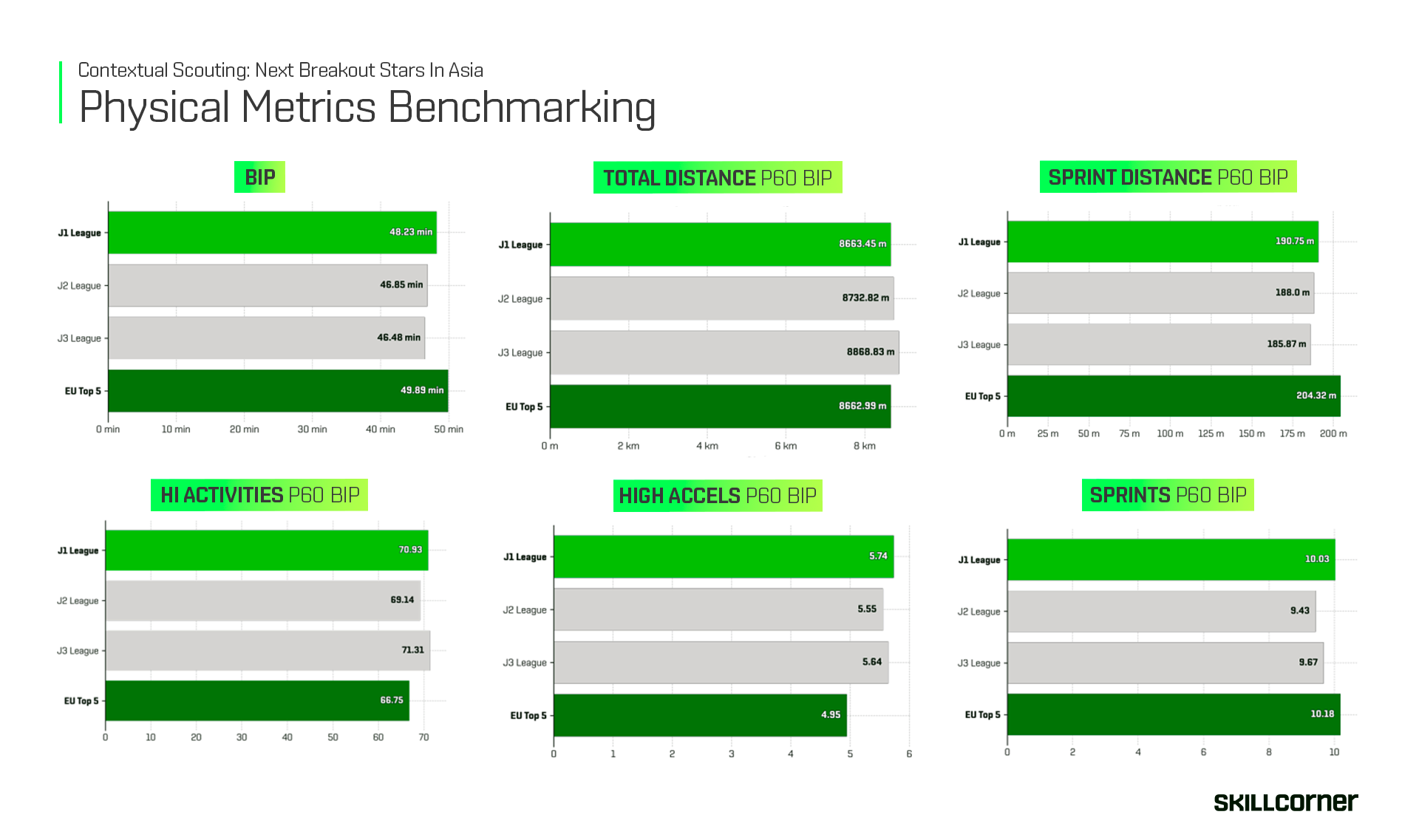
The data confirms that Japanese players run a lot from the Total Distance P60 BIP bar chart (top middle). However, the top five leagues score higher for Sprint Distance P60 BIP (top right), but this is boosted by the Premier League being a physical outlier as well. Further, when we look at the three bar charts on the second row, we can note that J1-league players average higher numbers for High Intensity Activities and High Accelerations P60 BIP. So, although the overall sprinting distance is higher in the top 5, the frequency of high intensity activities are higher in the J-League when the ball is in play. Let’s explore this further on a league level:

As seen above, the Premier League is a league on its own regarding sprint output. More interestingly, the data tell us that J-league players record above average numbers of high intensity accelerations each game, and we start to see why they adapt quickly in Germany and the Netherlands - matching the sprinting distance in those leagues (J2 League included).
A research paper we did on tactical trends across leagues for the 2024/25 season found that successful teams in Japan typically play direct transition-based football. We can break this down by looking at the different team styles within the league from the current season. Below, we have highlighted the teams that finished in the top four in the J1-league last season:

The direct teams we’ve highlighted all finished in the top four last season, with Vissel Kobe securing their second consecutive league title. What these sides have in common is a clear tendency toward directness - all of them score above average (green scores) in either Direct Play or Transitions. A few teams, however, have sought to deviate from this trend. Kashiwa Reysol, led by Spanish manager Ricardo Rodriguez, stands out as a notable example. They currently sit inside the top three and have just reached the Japanese league cup final, where they will face Sanfrecce Hiroshima, who ranks highly for direct play and quick breaks. An exciting watch for sure!
Revisiting our research on tactical trends, we also found that the Bundesliga was the most direct league amongst the top five - favouring directness over the progression to build up. This supports the idea that Japanese players are naturally well-suited to the Bundesliga’s direct playing style.
In summary, Japanese players adapt well to the technical and physical demands of Europe’s highest level, making them attractive targets at affordable prices.
In the next section, we will pick a specific scenario and look for the next breakout stars in Japan and South Korea.

Club Context: Bundesliga Club Targeting A Dynamic and Robust Playmaker in Asia
In this scenario, we take on the role of a Bundesliga club searching for a dynamic and robust playmaker from Asia, with a primary focus on Japan. Our scouting scope includes the ongoing 2025 season of the Japanese J1 and J2 Leagues and the South Korean K1 League.
The target profile thrives as a central attacking midfielder (CAM) in a 4-2-3-1 system, but can also operate as a right or left attacking midfielder, rotating positions within the trio to receive both centrally and wide. The player can also fit naturally into a 3-4-2-1 structure, occupying one of the two advanced playmaking roles behind the striker.
We’re looking for a player who is dynamic, mobile, and capable of influencing the game through off-ball movements and sharp decision-making in transitions. The ideal candidate blends technical quality with tempo and verticality, aligning with a Bundesliga style built on intensity and direct attacking play.
Methodology
We are going to apply The Playmaker Index and The Pressing Index, similar to our previous pieces on Scandinavia and South America. In those pieces, we experimented with different weightings for the indices. But this time, we are going to change some of the Game Intelligence metrics inside the Playmaker Index to suit more of a transitional and direct style of play, in line with our analysis of the J-League. The pressing index remains unchanged as we believe it mirrors the modern pressing game quite well. Below is our new combination of metrics to make up the “vertical” playmaker index:
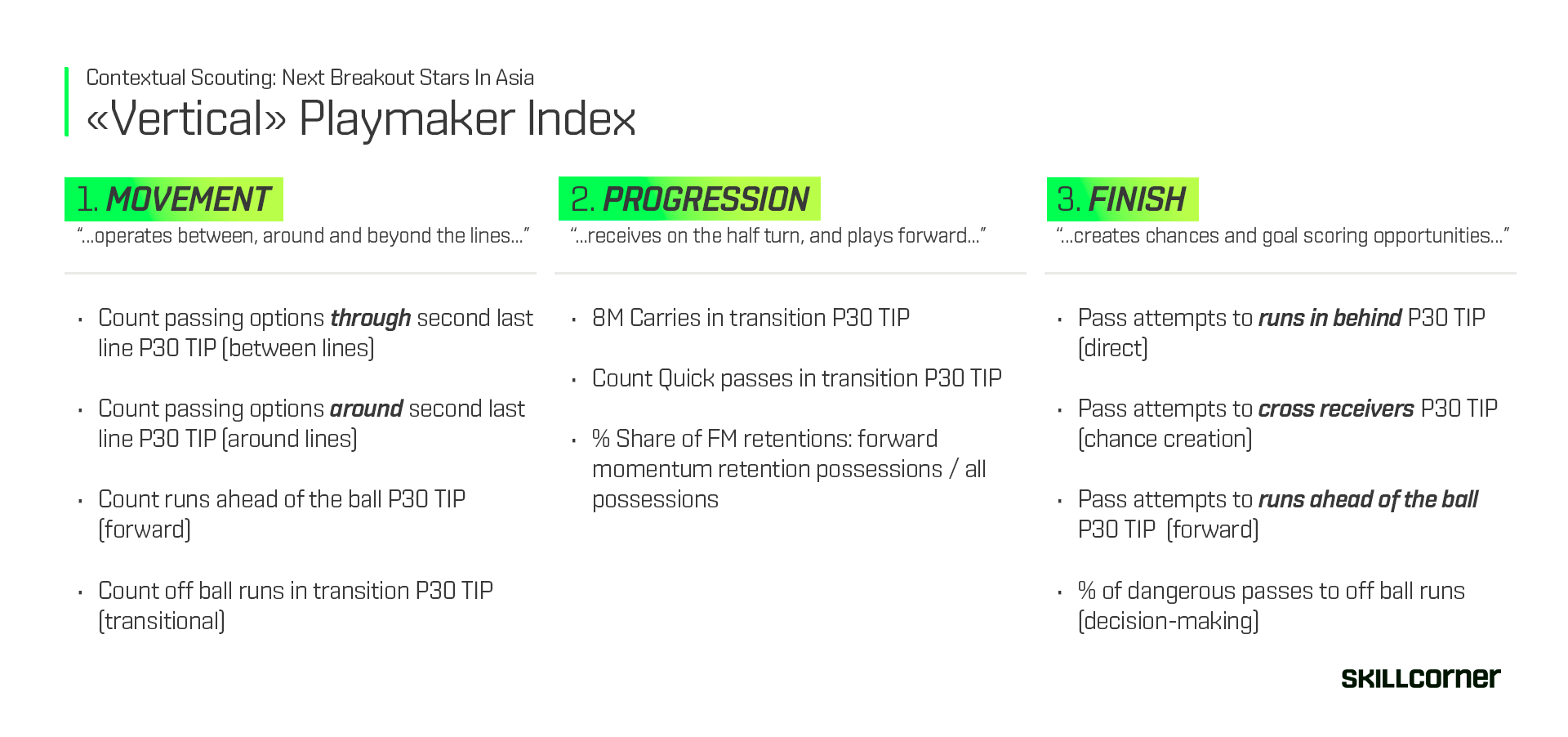
In the Movement category, we continue to use passing options to represent how players position themselves to receive between the lines, but we’ve now added a vertical layer with runs ahead of the ball and off-ball runs in transition. Together, these indicators aim to identify players who combine intelligent positioning to receive between lines (high technical proficiency) with the ability to target and exploit space when it opens up.
In the Progression category, we’ve shifted the focus toward the transitional phase, emphasizing players who move the ball forward with speed and intent. The phase now combines 8-meter carries in transition and quick passes in transition to capture progression through both carries and playmaking tempo. We’ve kept the forward momentum metric - measured as the share of FM retention relative to all possessions, to ensure we still identify players who consistently advance play across all phases, not only in transition.
Since we are not focusing solely on players that can break down a low block, we have removed the finish phase here as well. Furthermore, measuring pass attempts to runs in behind can reveal more impact across multiple phases - particularly in moments with more space to attack (which would be from Build-Up or Create) . In addition, we’ve chosen not to isolate all metrics solely within the transition phase, since transitions still occur far less frequently (only 4-6 % of game phases) than sustained periods of controlled possession.
With this setup, the index is intended to surface players who carry vertical threat without only depending on counterattacks - the kind of dynamic playmakers suited for high-tempo leagues like the Bundesliga.
With the adjustments complete, it’s time to see the results. Which players are emerging as the next breakout stars in Asia/Japan?

Our shortlist features several exciting young players. At the top is Sota Kitano (21), who recorded the highest Total Index Score. He’s joined by other rising talents like Sang-Yun Kang (21) from the K1-League and Kota Tawaratsumida (19) from FC Tokyo. The players highlighted in dark green are slightly older but remain intriguing options - their experience could help them adapt and break out in new environments.

Breakdown of Breakout Stars
Let’s take a closer look at how they perform across the different categories, both in and out of possession.
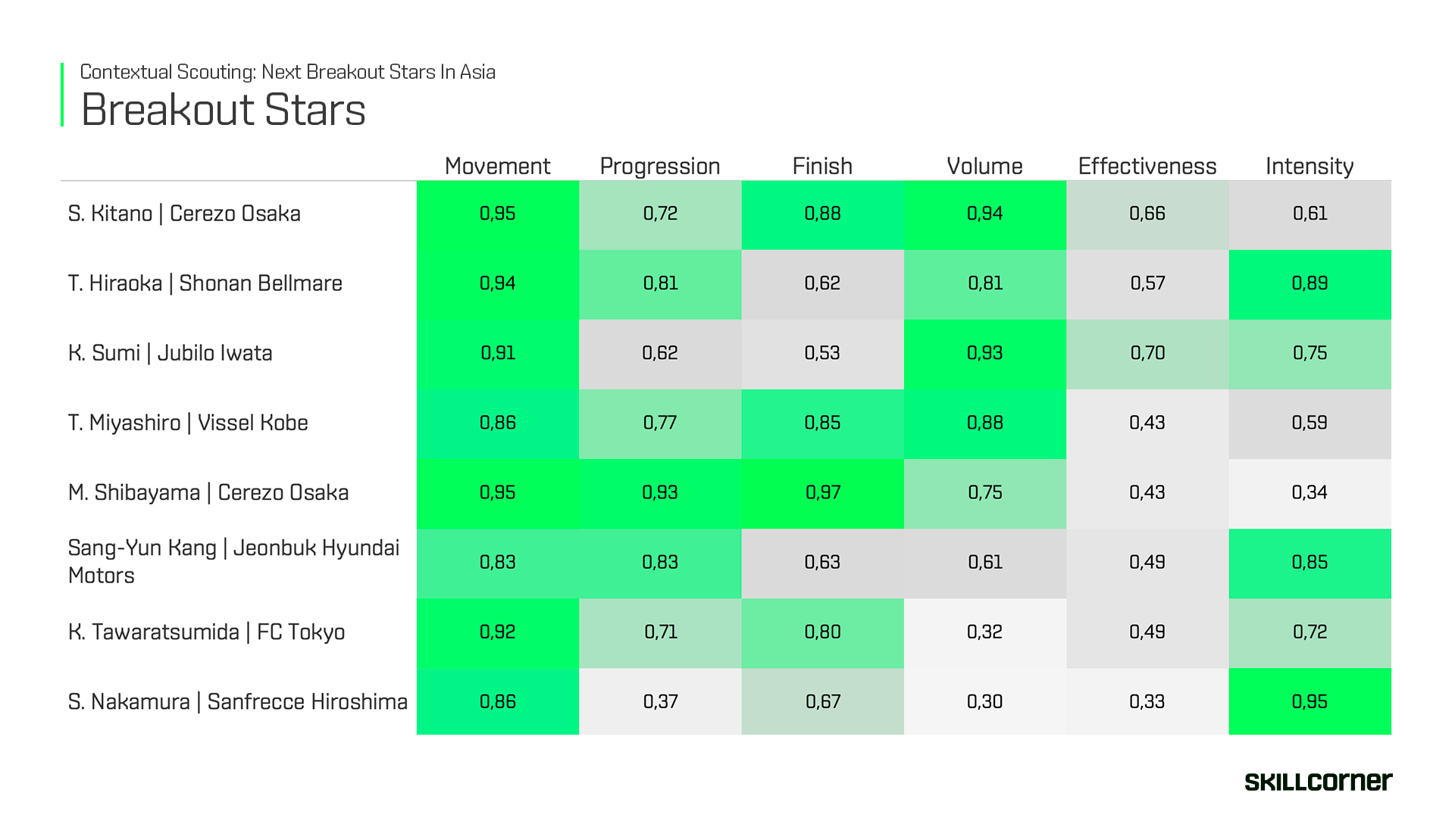
The first thing that stands out is how all of our players excel in the Movement category, each scoring at least in the 83rd percentile. When we move to Progression and Finish, scores are more modest with the exception of Shibayama who looks like a complete playmaker based on our index.
On the defensive side, four players stand out in the Volume category, while another four appear notably more intense and explosive than the rest.
It will be interesting to explore and compare the players’ movement profiles in more detail, as this seems to be the area where they truly distinguish themselves. Let’s explore this further.

Playmaker Analysis
Returning to our initial target profile, we aimed for a dynamic and robust playmaker capable of influencing the game through intelligent off-ball movement, quick combinations, and sharp decision-making in transitions.
Below is a scatter plot of our players ability to move between the lines, represented by their passing options through the second last line (x-axis) and around the second last line (y-axis) per 30 Tip:
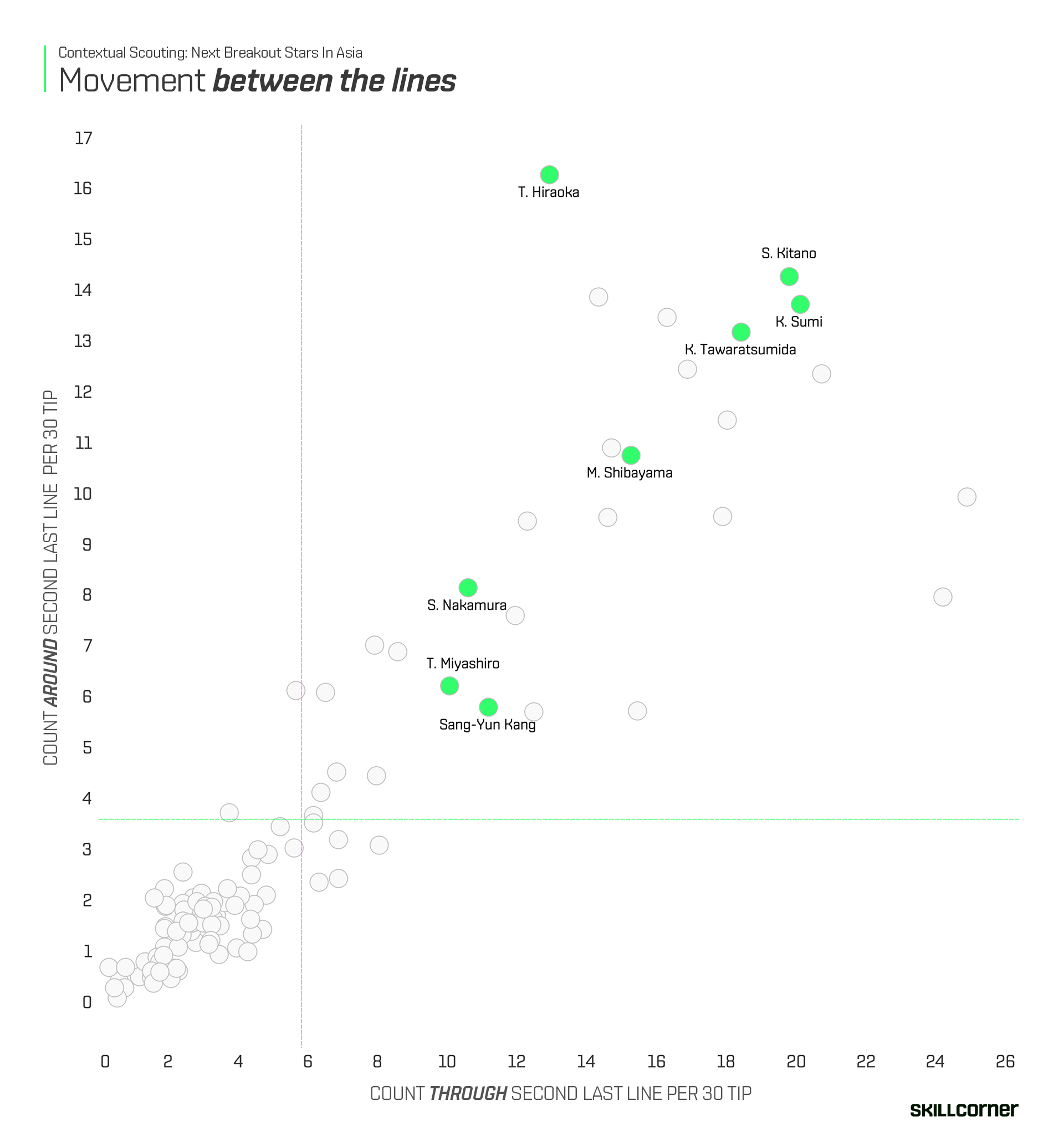
As expected, all of our shortlisted players rank above average for both movements. However, four players clearly stand out across both metrics: Kitano, who records the highest total of passing options, followed closely by Tawaratsumida, Sumi and Hiraoka who most often drifts out wide. Notably, Koshiro Sumi has been playing in the J2 League this season, yet still ranks among the top three in our Total Index Score.
Since all of our players display strong numbers and demonstrate intelligent movement to receive the ball in advantageous areas, we have to distinguish them by their ability to move forward into space.
Consequently, our visualization below highlights the players runs ahead of the ball (x-axis) and off-ball runs in transition (y-axis) Per 30 Tip:
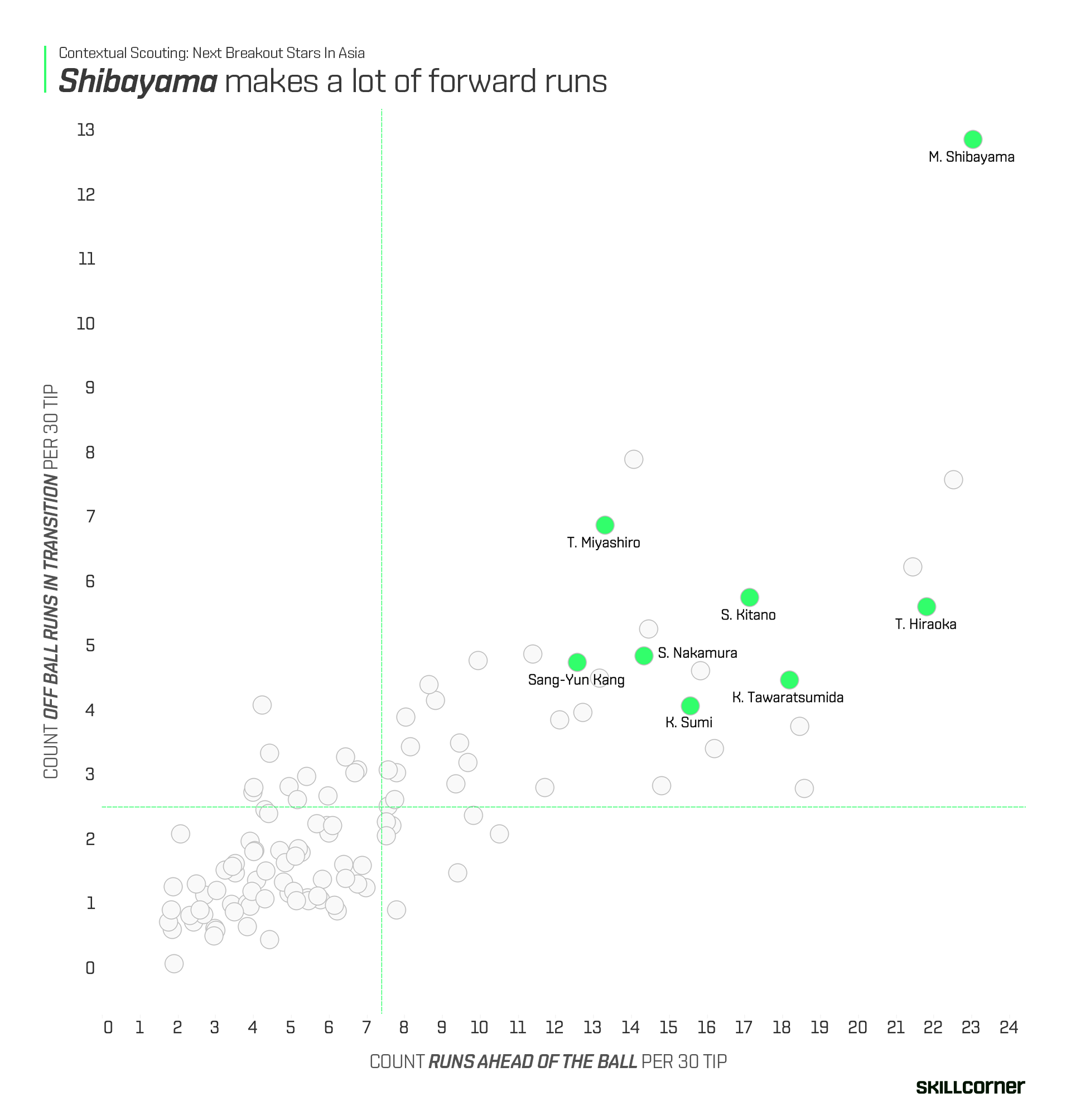
While Shibayama ranked slightly lower than the top group in the previous chart, he stands out here as a clear outlier. His exceptional score for off-ball runs in transition sets him apart, making him a player worth keeping a close eye on as we move forward in our analysis.
We’ve now established that all of our players are above-average movers, each meeting our criteria for being dynamic and mobile. But how do they help their team progress the ball and create chances?
First, let’s look at how the players rank in terms of carries (x-axis) and quick passes (y-axis) in transition Per 30 Tip:
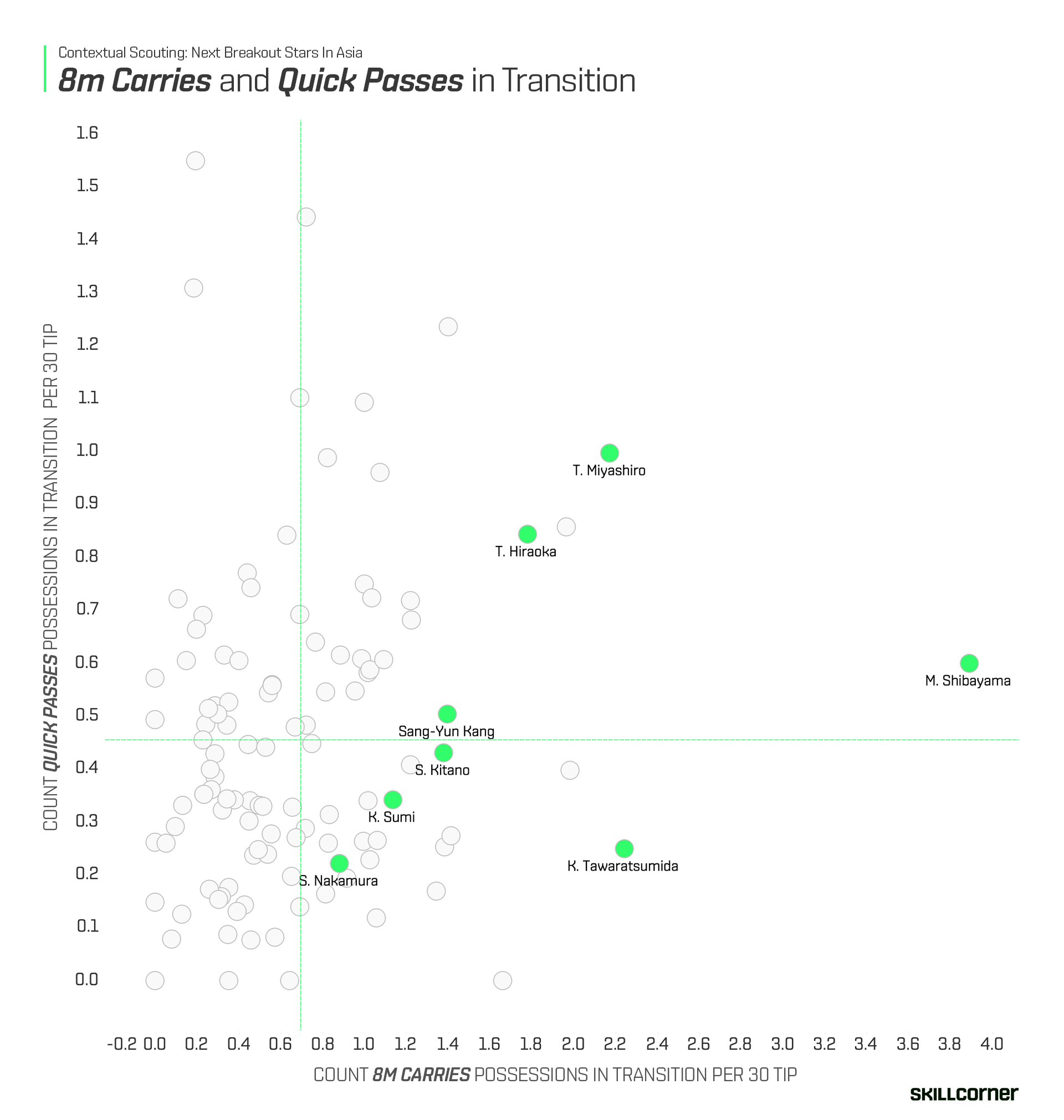
All of our players rank above average for carries, with Shibayama leading the way at nearly four carries per 30 TIP. On the other hand, Miyashiro and Hiraoka record the highest numbers for quick passes - a stronger indicator of playmaking ability and decision-making speed, as these actions require receiving and releasing the ball within one second.
Next, we want to look at how our players perform for our most important direct chance creation metrics: pass attempts to runs in behind (x-axis) and cross receiver runs (yaxis).
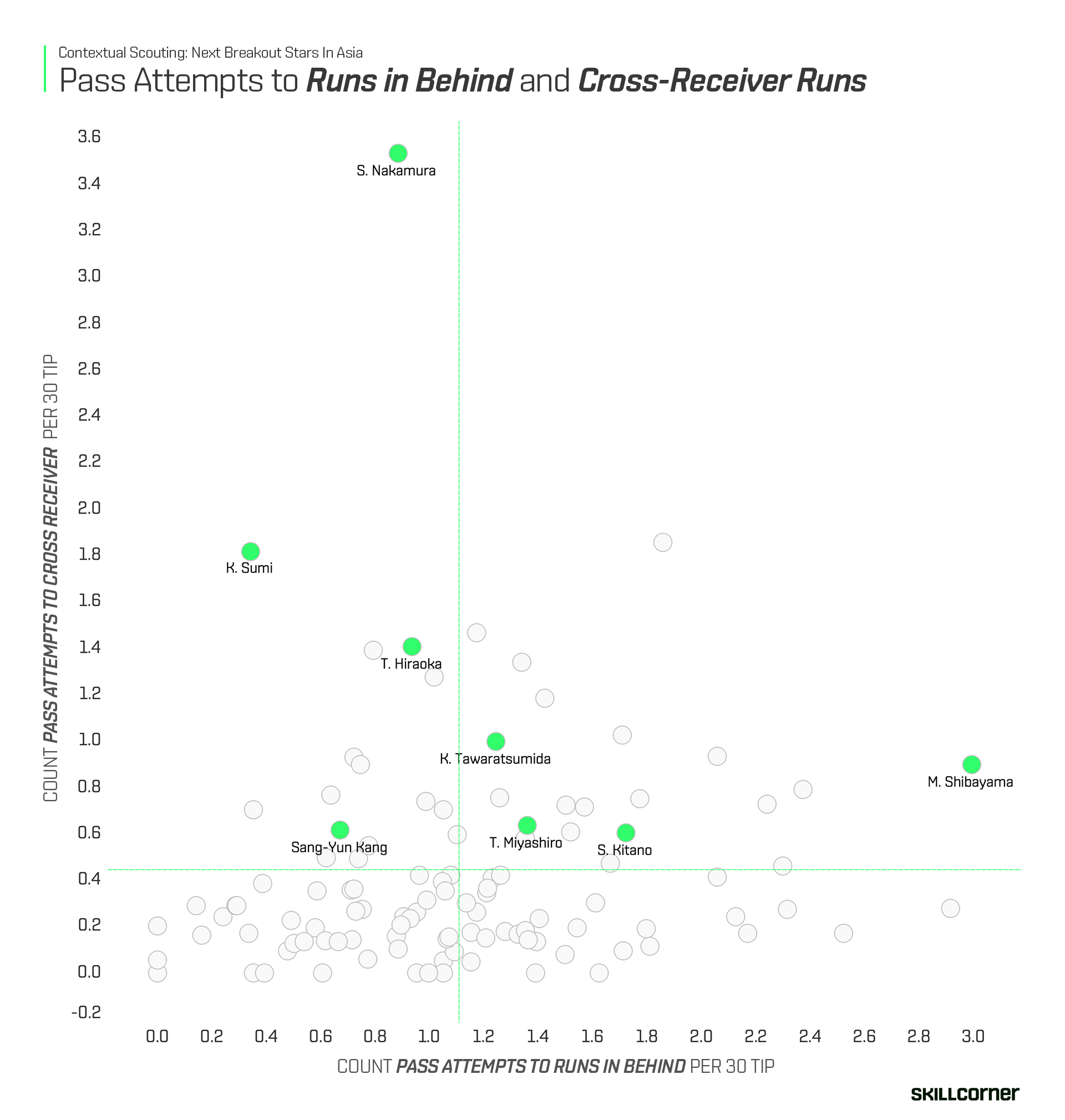
In terms of chance creation, Shibayama stands out once again - this time for his high frequency of passes played to runs in behind. On the opposite side of the plot, Sota Nakamura emerges as one of the most active crossers, which aligns with his six assists so far this season for Sanfrecce Hiroshima. The remaining players fall somewhere in between, displaying a balanced mix of both passing profiles.
At this stage, it remains challenging to clearly separate the players from one another. To build a more complete picture, we’ll now shift our focus to the Pressing Index, comparing their defensive contributions and physical profiles. The next steps will help us determine which players look most promising overall based on the data.

Pressing Analysis
Let’s find out how our players rank in terms of their on ball engagements (defensive output) in the high and medium block:
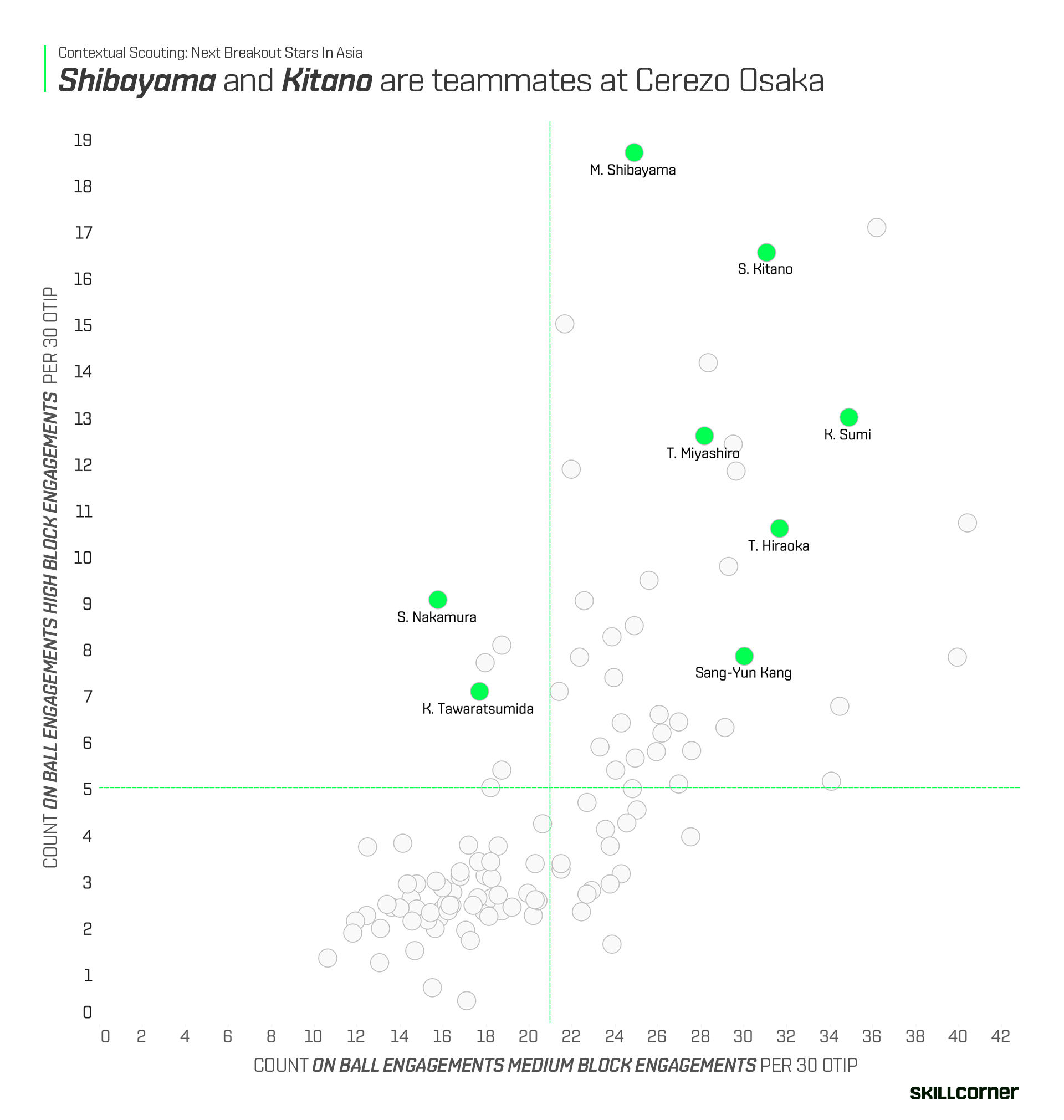
Six of our players rank above average for on-ball engagements in both the high and medium blocks. Among them, Shibayama and Kitano stand out - which makes sense given that they both play for Cerezo Osaka. A closer look at the data confirms that Cerezo spend most of their out of possession time in the high block. A similar pattern appears with Miyashiro and Sumi, whose teams (Vissel Kobe and Júbilo Iwata) also operate higher up the pitch, suggesting that team style plays a key role in shaping these metrics.
Interestingly, Hiraoka’s team, Shonan Bellmare, spends the most time in a low block when out of possession - yet he still ranks highly in the other pressing zones. This suggests that Hiraoka could fit into multiple pressing systems effectively.

Physical Analysis
To complete our analysis, we turn to physicality. Earlier in this piece, we noted that Japanese players tend to cover large distances, although their total sprinting distance is slightly lower compared to some of the top European leagues. We now want to examine how our selected players perform in terms of sprinting activities and sprinting distance, to assess whether they can meet the physical demands of the Bundesliga.
The scatter plot below benchmarks each player’s sprint output against the average values for Bundesliga midfielders from the 2024/25 season - dotted lines mark the Bundesliga average. The background sample includes all midfielders in the J1 and J2 league this season.

Interestingly, all of our players appear capable of coping with the sprinting demands of the Bundesliga. Kota Tawaratsumida stands out as the clear leader - while Sumi, Nakamura, Kitano, and Hiraoka also record high scores. It’s also worth noting that Nakamura has the highest Peak Speed Velocity (PSV-99) and the fastest time to sprint, reflected in his 95th percentile score for our Intensity category from the breakdown.
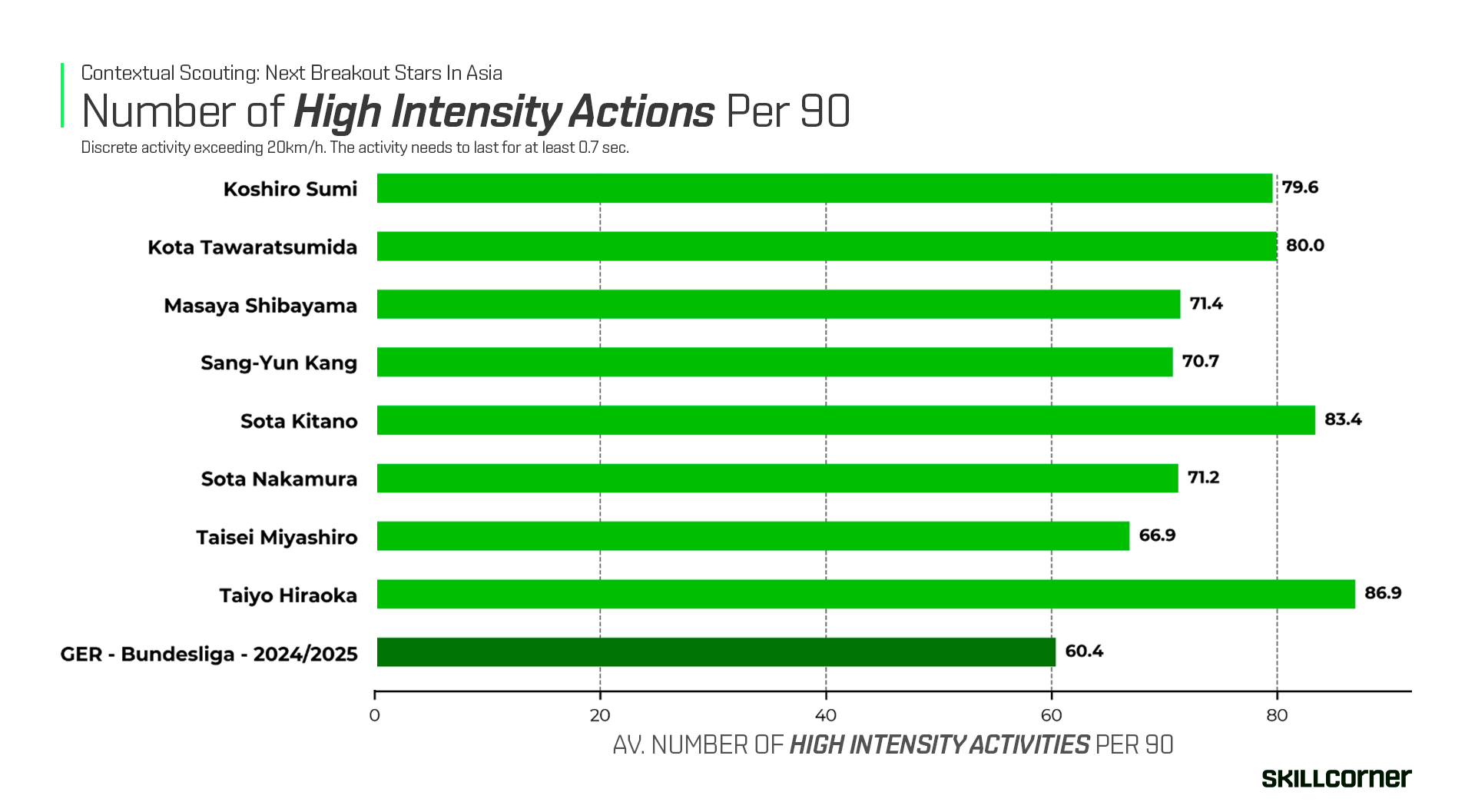
We can also complement the sprint data with high-intensity actions p90, which include all movements above 20 km/h. In this category, Kitano and Hiraoka emerge as the standout performers.
It’s time to narrow down our shortlist of potential targets, as we now have enough information from our analysis. The decision on which players to scout further comes down to a holistic assessment of their qualities both in and out of possession.

The Shortlist
After combining all our insights, we’ve identified four players to focus on: Sota Kitano, Taisei Miyashiro, Taiyo Hiraoka, and Masaya Shibayama. However, upon reviewing each player more closely, we found that Sota Kitano has already completed a transfer to Red Bull Salzburg in Austria. This narrows our list down to three remaining candidates.

Below are the off ball profiles of our final candidates, allowing us to analyze the main differences between them off the ball:
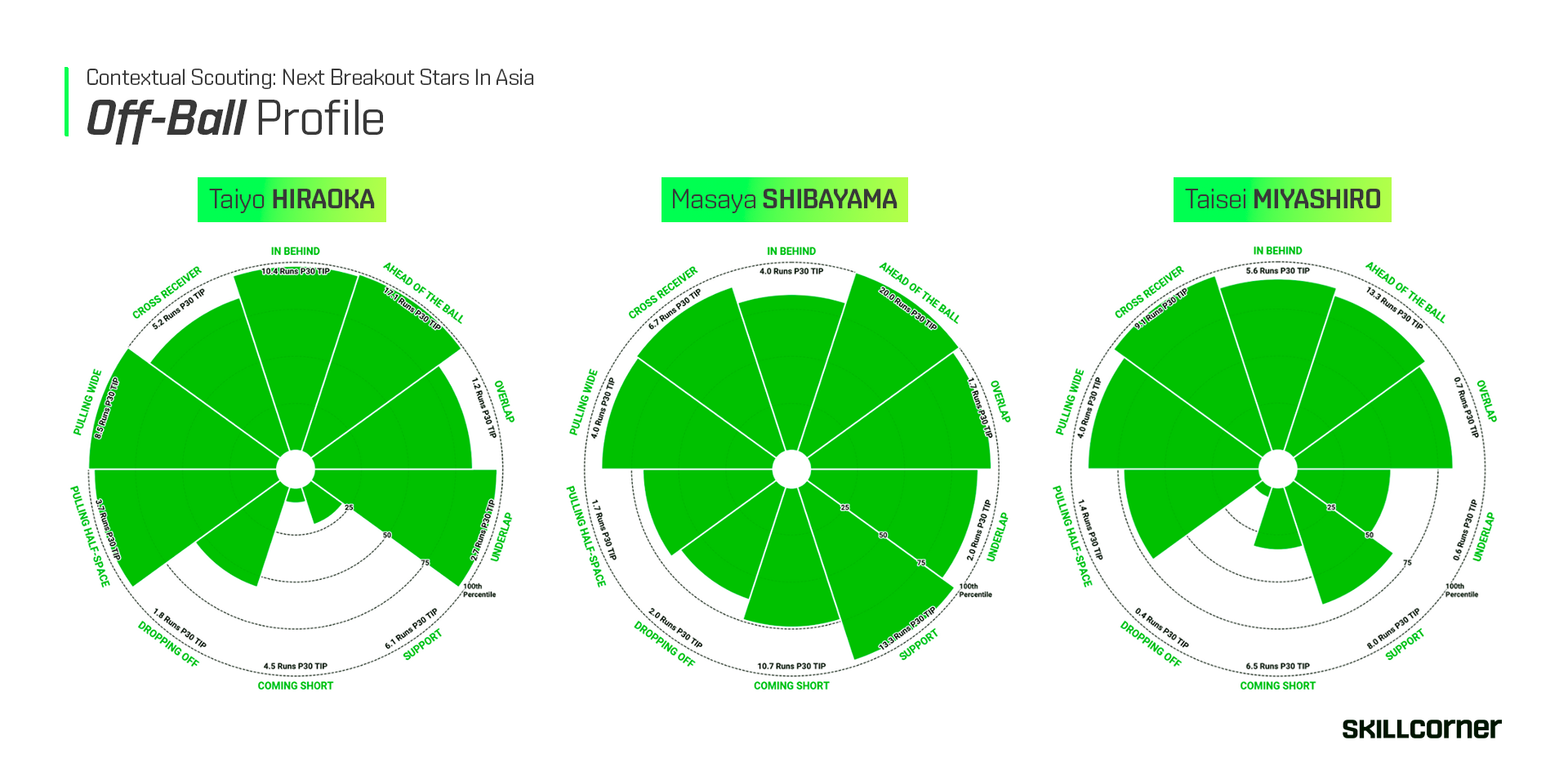
We’re now left with three dynamic playmakers who move well between the lines. All three also meet our criteria of being direct and vertical, reflected in their frequent runs in behind and runs ahead of the ball per 30 Tip.

Contextual Scouting: From Data to Decision
Masaya Shibayama (23) clearly distinguishes himself from the others through his greater involvement in build-up play, as shown by his dropping off runs and coming short runs. His high score for support runs is also a great asset for aiding ball circulation and helping his team up the pitch. From video scouting, he comes across as an exceptional left-footed technician, combining low centre of gravity with tight close control. However, his small stature (1.61 m) means he could be physically challenged in more demanding environments. Another factor is sample size - he has only five full games in our dataset, although his playing time has increased since Kitano’s transfer to RB Salzburg. His data profile is very promising, and he’s certainly a player to keep monitoring as he continues to develop and gain influence in the J1 League.
Moving on to Taisei Miyashiro (25) of Vissel Kobe, who ranks fourth in our Total Index Score. What sets him apart from the other two is his strong output for cross-receiver runs, averaging 9.1 runs per 30 TIP as a midfielder.
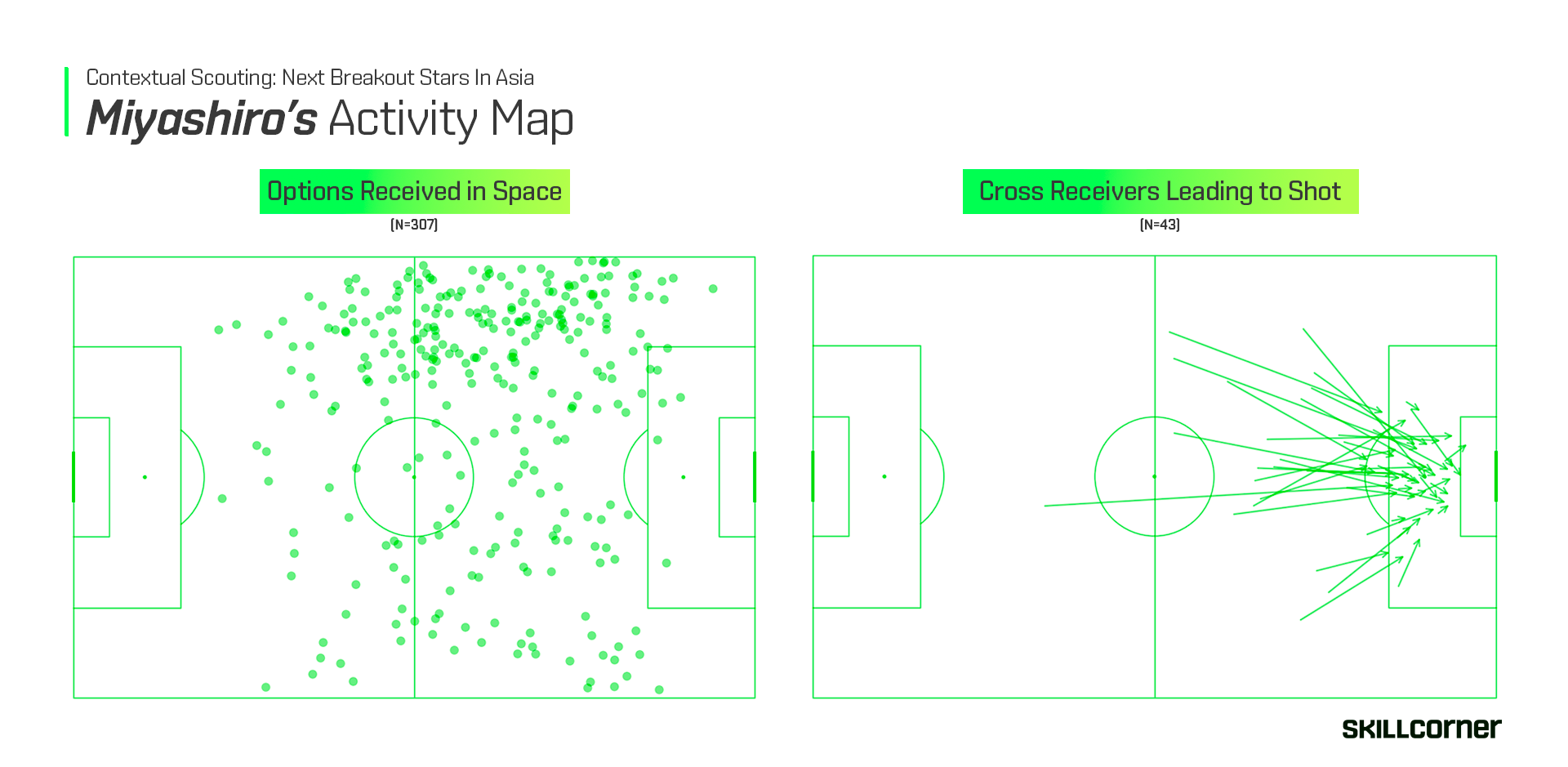
If we were specifically targeting a more goal-scoring attacking midfielder, he would be a standout candidate - registering 11 goals and 3 assists this season for the reigning champions. This attacking instinct is also reflected in his positional split, featuring in 11 games as a center forward and 15 as a midfielder in our dataset. His high score for on-ball engagement in the high block further suggests he could thrive in a direct pressing system, combining experience as a forward leading the press with the ability to arrive late in the box as a number eight. Clubs with a direct and aggressive playing style should definitely keep Miyashiro on their radar.
Lastly, we have Taiyo Hiraoka (23), who ranks second in our Total Index Score and displays strong, consistent numbers across all categories - including the physical robustness required for the Bundesliga. It’s important to note that Hiraoka plays for Shonan Bellmare currently sitting in one of the relegation spots. The team has underperformed their expected goals (for and against), but should still be considered a mid-to-lower-table side in terms of underlying performance. Hiraoka’s off ball profile shows the offensive qualities we are after as he moves well between the lines, and combines this with vertical runs scoring in the 99th percentile for both runs ahead of the ball and underlap runs per 30 Tip. He demonstrates these qualities despite playing in a more possession-oriented team, in contrast to Miyashiro, who operates in a more direct system. Below, we have visualized Hiraoka’s receptions in space and runs ahead of the ball:

From watching him play, it’s clear that Hiraoka fits the profile we’re looking for. He constantly seeks space, alternating between finding pockets in the left half-space and drifting wide when needed. He looks like a natural fit for the left-sided attacking midfielder role in a 4-2-3-1, ideally paired with an overlapping fullback - but could potentially be even more effective as an inside forward, drifting and dropping deeper to link play and attack central spaces. His ability to combine in tight areas also makes him a strong candidate for the left number 10 role in a 3-4-2-1 system.
One area for improvement is his direct goal contribution as he only has 3 goals and 1 assist this season. However, one could argue that Hiraoka might perform even better in a stronger team.
Hiraoka’s value lies in his intelligent movement, high pressing volume, and physical output (explosivity included). He offers constant availability in possession and relentless work out of it - qualities that often translate well to higher-intensity leagues. With a market value of just €550k, he could represent excellent value for a Bundesliga club seeking a dynamic and robust number playmaker, capable of adjusting to different team styles and systems.
👉 Read the following articles to discover the complete series:
Contextual Scouting: The Modern Playmaker
Contextual Scouting: Pressing Playmakers
Contextual Scouting: Next Breakout Stars In Scandinavia
Contextual Scouting: Next Breakout Stars in South America

